October 2019 LIP of the Month
Discovery of the Central Atlantic magmatic Province “CAMP” activity in the External Rif (Northern Morocco)
Faouziya HAISSEN1 *, Oriol GIMENO-Vives2, Geoffroy MOHN2, Valérie BOSSE3, Mohamed Najib ZAGHLOUL4, Achraf ATOUABAT4 and Dominique FRIZON de LAMOTTE2
1 Université Hassan II de Casablanca, Faculté des Sciences Ben Msik, Département de Géologie, B.P.5366, Maarif, Casablanca, Maroc; email faouziya.haissen@gmail.com
2 Université Cergy-Pontoise, Département Géosciences et Environnement (GEG), 1 rue Descartes, 950000 Neuville/Oise Cedex, France
3 Université Blaise Pascal, Laboratoire Magmas et Volcans (UMR 6524), CNRS, 5 rue Kessler, 63038, Clermont-Ferrand, France
4 Université Abdelmalek Essaadi, Faculté des Sciences et Techniques de Tanger, BP 419, 90000 Tanger, Maroc
Figures and text extracted from “O. Gimeno-Vives, G. Mohn, V. Bosse, F. Haissen, M. N. Zaghloul, A. Atouabat, D. Frizon de Lamotte, 2019. The Mesozoic margin of the Maghrebian Tethys in the Rif belt (Morocco): Evidence for poly-phases rifting and related magmatic activity. Tectonics, 38, 1-25” and unpublished data.
Introduction
Extensive tholeiitic magmatism reported from different circum-Atlantic continents with similar geochemical signature (E-MORB) and fingerprints with similar ages around 201 Ma is known as the Central Atlantic Magmatic Province “CAMP” (Marzoli et al. 1999). In Morocco, CAMP activity has been reported and extensively studied in all structural domains from the Anti-Atlas, the Western and Central High Atlas, the Meseta and the Middle Atlas but never in the alpine Rif domain. This mountain chain in the northern Morocco, is located at the junction between the Mediterranean and the Central Atlantic Domains. Although the Rif belt underwent important Cenozoic (i.e., Alpine) compression, remnants of the Mesozoic North African rifted margin are preserved in its external zones. During a recent survey of the architecture and the evolution of this rifted margin, many scattered bodies of mafic rocks were sampled and studied (geochronology, geochemistry and isotopes). In almost all outcrops, the mafic rocks are overlain by dismembered and discontinuous blocks of Lower Jurassic carbonates covered by Middle to Upper Jurassic sediments (Figure 1). Different grain-size rocks were observed in the outcrops: basalts, dolerites, doleritic basalts, coarse-grained gabbros, gabbroic cumulates and few leucocratic segregations cross-cutting all the previous lithologies. The petrography of dolerites is invariably composed by Pl-Cpx (main minerals) together with rare Opx, rare or absent Ol in some samples, Fe-Ti oxides ± rare K feldspar ± rare Qtz, while gabbro’s petrography is dominated by Ol-Pl with Cpx ± Opx and the association biotite + Fe-Ti oxides (Figure 2). Variable degrees of post-magmatic alteration are observed dominantly greenschist (<400°C) or even lower temperature facies (<200°C). Some outcrops can be altered up to 90% and a myriad of secondary minerals reported (amphibole, chlorite, serpentine, iddingsite, talc, calcite, sericite, zeolite) accompanied in some samples by prehnite microveins.
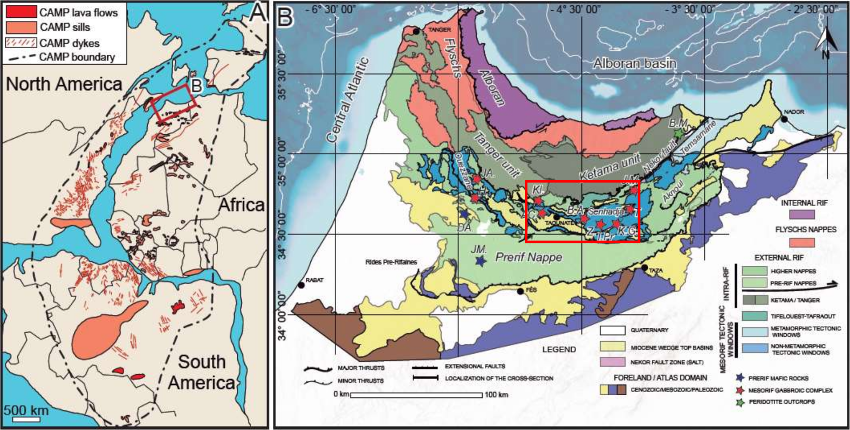
Figure 1. (A) Schematic reconstruction of the Central Atlantic region at about 200Ma, prior to the early Jurassic continental breakup (after Marzoli et al. 2014); (B) Structural map of the Rif belt in the North of Morocco (after Suter 1980; Chalouan et al., 2008). Principal tectonic units are shown with special emphasis on the External Rif. (b) Map of the western Mediterranean region showing the Alpine belt with the location of the Rif (modified after Vergés and Sàbat. 1999 (B.A: Bou Adel, B.M: Beni Malek, I.Pr: Internal Prerif, J.B: Jebel Baïo, K.G: Kef el Ghar, Kl: LaKlaaia, T: Taïneste, Z: Zitouna). The red square indicate where outcrops where geochronologic datind were performed.
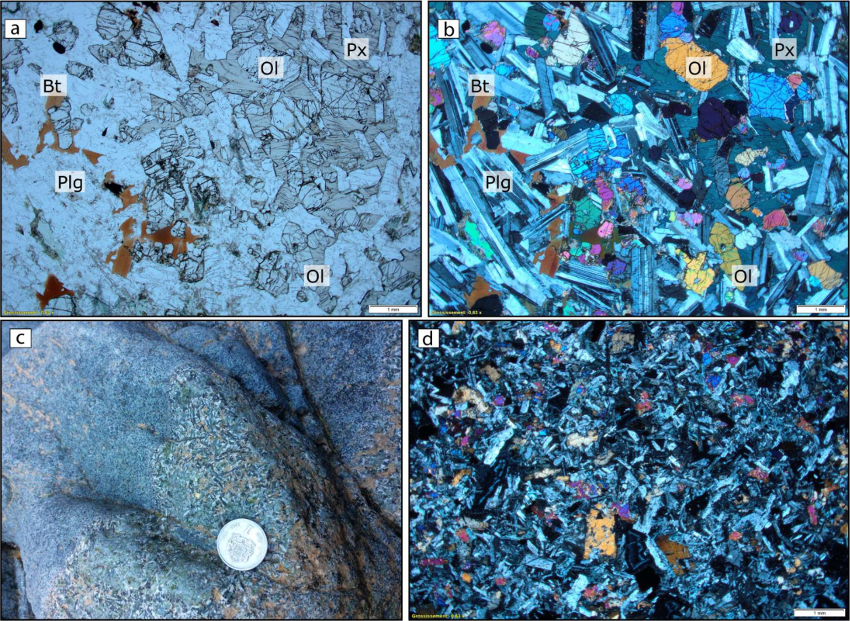
Figure 2. Petrography of the main lithologies of mafic bodies: Gabbroic cumulates from Bou Adel outcrop in (a) plane polarized light (b) in cross polarized light, showing peculiar heteracumulate texture with poikilitic clinopyroxene enclosing olivine and euhedral plagioclase ± orthopyroxene, Biotite and Fe-Ti oxides; (c) Different grain sizes Zitouna outcrop (coarse to medium grained) (d) Dolerite from Zitouna showing ophitic texture (Pl+ Cpx as main minerals ± Opx, Bt without olivine) and secondary minerals.
U/Pb laser Ablation data
U-Th-Pb isotopic data on separated zircons were obtained by laser ablation inductively coupled plasma spectrometry (LA-ICPMS) at the Laboratoire Magmas & Volcans (Clermont-Ferrand, France). Different lithologies with high probability to contain zircon in their mineralogy were selected: two dolerites from two different outcrops (RE-07 from Laklaiaa and RE-61 from Kef El Ghar); one gabbroic cumulate from Bou Adel (RE-27), and two leucocratic facies samples (REO-09 from Kef el Ghar and REO-47 from Jbel Bayo). In this last sample, no zircon was found making it impossible to date. U-Pb geochronology of zircons extracted and separated from the other 4 samples was conducted (Figure 3).
The crystallization ages of dolerites and gabbros yielded concordant 206Pb/238U ages ranging from 200 to 195 Ma (see Gimeno-Vives et al., 2019 for more details). RE-27 gabbro at ca. 196 ± 4 Ma; RE-61 dolerite, 195 ± 4 Ma; RE-07 dolerite sample 200 ± 4 Ma. While the leucocratic segregation from Kef el Ghar outcrop yielded a younger age at 192 ± 4 Ma in accordance and in the same error interval than the 190±2 Ma age obtained from similar facies in Bou Adel by Michard et al. (2018). An inherited zircon with age at 462 ± 9 Ma was reported from RE-61 Kef el Ghar dolerite. Michard et al. (2018) also reported an inherited zircon with age at 2 Ga. These inherited zircons were probably sampled from host rocks during magmas emplacement or during their ascent which is an additional evidence for the intraplate emplacement of these mafic bodies.
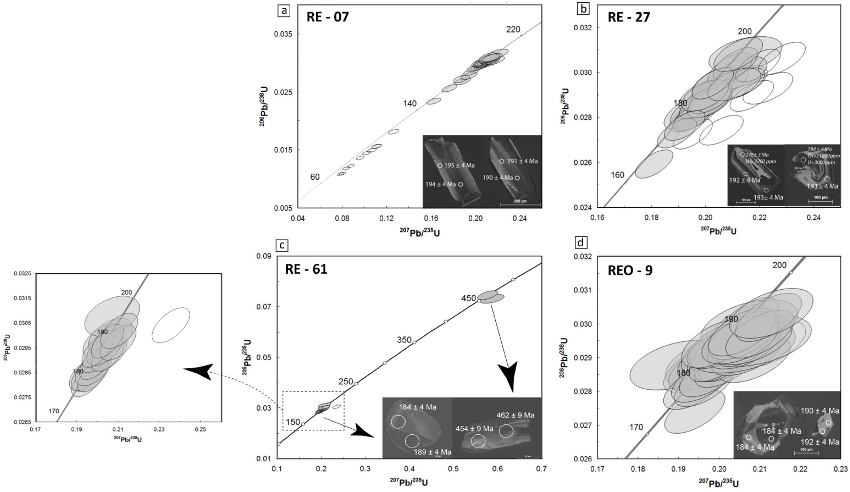
Figure 3. Concordia diagram and Cathodoluminescence images of dated zircon crystals from Laklaiaa (a), Bou Adel (b) and Kef el Ghar (c) and (d) with spot location with the related U–Pb ages (Ma).
This age interval of Rif samples, 200-192 Ma, match perfectly with the compiled radiometric data of CAMP rocks from about 202 to 192 Ma (Sebai et al., 1991; Marzoli et al., 1999; Hames el al., 2000; Deckart et al., 2005; Knight et al., 2004; Nomade et al., 2007; Verati et al., 2005 ; 2007; Jourdan et al., 2009; Blackburn et al., 2013; Davis et al., 2017; Marzoli et al. 2018 and references therein). All this data indicate an early peak of activity followed by late protracted low-volume magmatism until ca. 192 Ma (Marzoli et al., 2018 and references therein). In the frame of Moroccan CAMP, External Rif ages plot also in the same interval of ages (202-199 for Lower, Intermediate and Upper basalts of the Central High Atlas and 199-196 for the Recurrent Unit basalts, see Marzoli et al. 2018 & 2019 and references therein).
Major and Trace Geochemistry and Isotopes compositions (Unpublished data)
Most of mafic rocks are tholeiitic basalts, they plot in the subalkaline basalt field in the Zr/TiO2 vs. Nb/Y classification diagram (Winchester and Floyd, 1977) more suitable for the classification of such heavily altered rocks (Xia and Li, 2019). Based on their Nb/Y and Zr/P2O5 ratio values (Floyd and Winchester, 1975), most of samples classify as tholeiitic rocks. Most sample compositions overlap perfectly the compositions of CAMP rocks compiled from Morocco and other sides of the CAMP area (Verati et al. 2005; Deckart et al., 2005; Mahmoudi et al., 2007; Martins et al., 2008; Chabou et al., 2010; Bensalah et al., 2011; Merle et al., 2011; Marzoli et al., 2011; 2014; 2019; Callegaro et al., 2014; Cirricione et al., 2014; Meddah et al., 2017; Heimdal et al., 2019).
Comparing the distribution of rare earth elements in multi-element patterns normalized to the primitive mantle (Sun and McDonough, 1995), the Rif samples typically display large-ion lithophile elements (LILE as Ba, Rb, K, Th, U) and light rare earth elements LREE enrichments compared to N-MORB and E-MORB (Figure 4). The enrichment in Rb, Ba, Th and K are related to post-magmatic alteration processes. All facies show negative anomaly in Nb and Ta and positive anomaly in K. Such enrichment in most incompatible elements (Rb, Th, Ba, K) compared to Nb, Sr, Ce, Ti and Y with marked Nb-Ta depletion is characteristic of CAMP rocks (e.g. Marzoli et al. 2018).
The Chrondrite-normalized rare earth elements REE diagrams (Boynton, 1984) for the studied samples show sub-parallel patterns with enrichment in LREE compared to heavy REE, HREE which is a typical behavior of E-MORB roks (Figure 4). Some samples are more fractionated than others (as for example Bou Adel samples). Weak negative Eu anomaly is generally observed except in samples from Bou Adel outcrop which display an important positive anomaly (up to 1.83), indicating that plagioclase was a major accumulating phase.
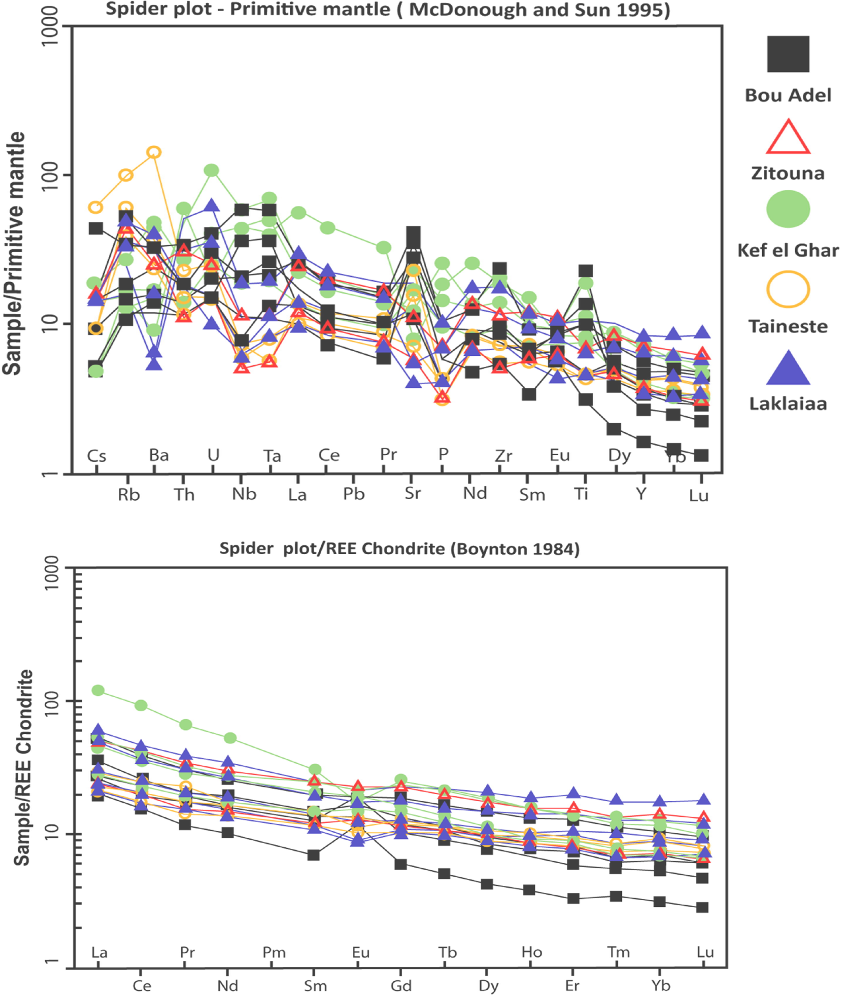
Figure 4. Multi-elements diagram normalized to primitive mantle using values from McDonough and Sun (1995) and Chondrite-normalized REE diagram (Boynton, 1984). All facies included (dolerites, basalts, gabbroic cumulates, habbros and leucocratic segregations).
Therefore, the observed trends and the observed anomalies in Nb and Ta (in Ti) characteristic of most CAMP basalts are frequently encountered in within-plate continental basalts that interacted with the continental lithosphere (crust or mantle).
Isotopic compositions for these mafic rocks (unpublished data with 87Sr/86Sr201Ma : 0.70424-0.70668 and 143Nd/144Nd201Ma : 0.51182-0.51265 with εNd201Ma ranging from -1.51 to +4.85. Such values match perfectly those of the CAMP rocks mainy Low-Ti Group which permit to include the Rif mafic magmatism in the CAMP activity extending so this province to the Rif belt in the North of Morocco.
Conclusion
The mafic magmatism related to the Central Atlantic magmatic province was emplaced in the Rif basin (in the North African palaeo-margin) during a first Late Triassic phase of rifting which was marked by the development of isolated basins filled with continental deposits and evaporates (Figure 5). This rifting phase was responsible for initial crustal and lithospheric thinning ending with the emplacement of mafic magmatic intrusions. The mafic bodies were exhumed during a second phase of rifting during the Middle Jurassic, which led to the opening of the Maghrebian Tethys. This second rifting phase ended with the exhumation of the subcontinental mantle (Beni Malek serpentinites ) occurring at the bottom of the Intrarif during the Upper Jurassic.
Gimeno-Vives et al., (2019) documented the complex interactions between poly-phase rifting recorded in the North African paleo-margin, CAMP-related magmatism and salt tectonics in controlling the architecture and evolution of the Maghrebian Tethys at the junction between the Central Atlantic and Alpine Tethys. The presence of an initial rift event during the Late Triassic, a precursor of a second successful rift event, appears to be a common feature at the scale of North Africa and Western Europe.
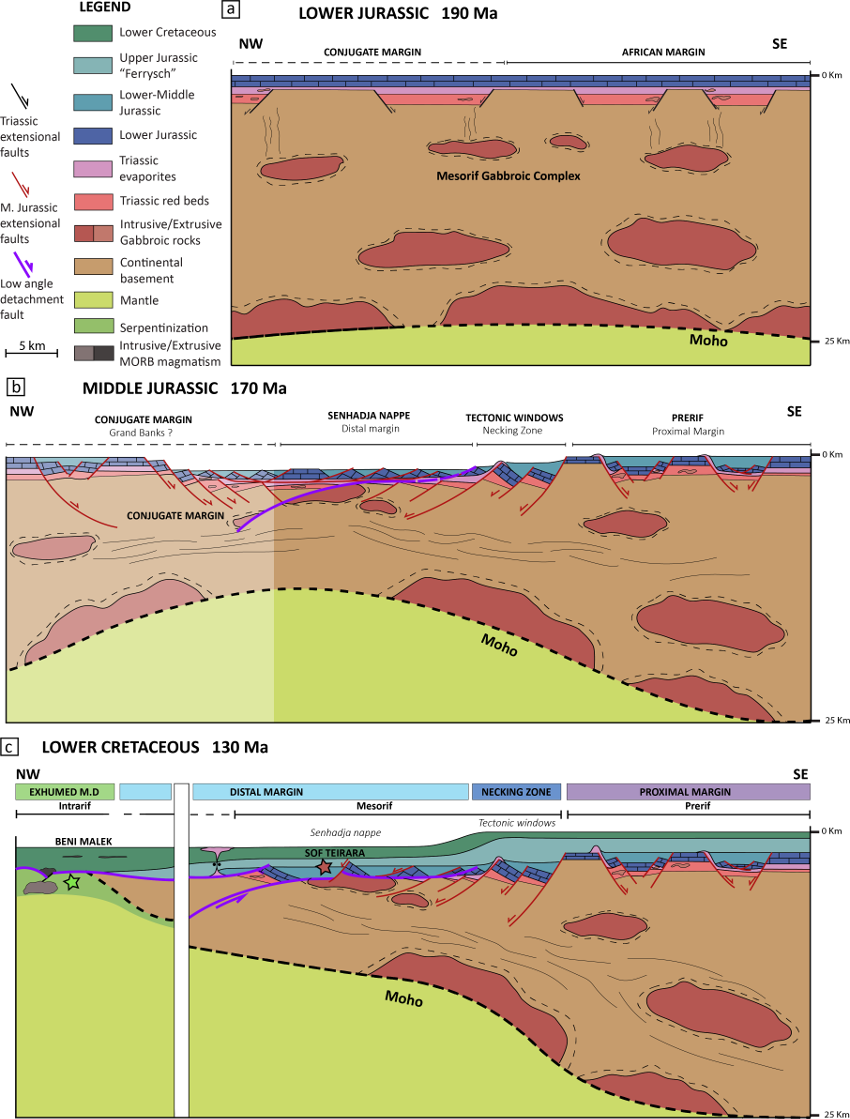
Figure 5. Idealized evolution of the North African rifted margin across the Rif Belt (Morocco) from the Lower Jurassic to the Lower Cretaceous Gimeno-Vives et al., 2018 (a) Schematic cross-section of the Rif basin during the Lower Jurassic. This period is characterized by the deposition of shallow marine carbonates, sealing a previous Triassic rifting phase. The potential location of gabbroic intrusions (i.e. Mesorif gabbroic complex) is indicated. (b) Schematic cross-section during the Middle Jurassic representing the main rifting phase.
References
Benzaggagh, M., Mokhtari, A., Rossi, P., Michard, A., El Maz, A., Chalouan, A., Saddiqi, O., Rjimati, E. (2014). Oceanic units in the core of the External Rif (Morocco): Intramargin hiatus or South-Tethyan remnants? Journal of Geodynamics, 77, 4–21
Blackburn TJ, Olsen PE, Bowring SA, Mclean NM, Kent DV, Puffer J, McHone G, Rasbury ET,Et-Touhami M (2013) Zircon U-Pb geochronology links the end-Triassic extinction with the Central Atlantic Magmatic Province. Science 340:941–945
Boynton, W.V. (1984) Geochemistry of Rare Earth Elements: Meteorite Studies. In: Henderson, P., Ed., Rare Earth Element Geochemistry, Elsevier, New York, 63-114
Callegaro S, Rapaille C, Marzoli A, Bertrand H, Chiaradia M, Reisberg L, Bellieni G, Martin L, Madeira J, Mata J, Youbi N, De Min A, Azevedo MR, Bensalah MK (2014a) Enriched mantle source for the Central Atlantic magmatic province: new supporting evidence from Southwestern Europe. Lithos 188:15–32
Chabou MC, Bertrand H, Sebaï A (2010) Geochemistry of the Central Atlantic Magmatic Province (CAMP) in south-western Algeria. J Afr Ear Sci 58:211–219
Chalouan, A., Michard, A., El Kadiri, K., Negro, F., Frizon de Lamotte, D., Soto, J. I., Saddiqi, O. (2008). The Rif belt. In: Michard, A. (Ed.), The Geology of Morocco. Springer, Berlin, pp. 203–302
Davies JHFL, Marzoli A, Bertrand H, Youbi N, Ernesto M, Schaltegger U (2017) End-Triassic mass extinction started by intrusive CAMP activity. Nat Commun. https://doi.org/10.1038/NCOMMS15596
Deckart K, Bertrand H, Liégeois J-P (2005) Geochemistry and Sr, Nd, Pb isotopic composition of the Central Atlantic magmatic Province (CAMP) in Guyana and Guinea. Lithos 82:289–314
De Min A, Piccirillo EM, Marzoli A, Bellieni G, Renne PR, Ernesto M, Marques LS (2003) The Central Atlantic Magmatic Province (CAMP) in Brazil: Petrology, geochemistry, 40Ar/39Ar ages, paleomagnetism and geodynamic implications. In: Hames W, McHone G, Renne PR, Ruppel C (eds), The Central Atlantic magmatic province: Insights from fragments of Pangaea. Am Geophys Un Geophys Monogr 136:91–128
Hames WE, Renne PR, Ruppel C (2000) New evidence for geologically instantaneous emplacement of earliest Jurassic Central Atlantic magmatic province basalts on the North American margin. Geol 28:859–862
Jourdan F, Marzoli A, Bertrand H, Cirilli S, Tanner LH, Kontak DJ, McHone G, Renne PR, Bellieni G (2009) 40Ar/39Ar ages of CAMP in North America: implications for the Triassic-Jurassic boundary and the 40K decay constant bias. Lithos 110:167–180
Knight KB, Nomade S, Renne PR, Marzoli A, Bertrand H, Youbi H (2004) The Central Atlantic Magmatic Province at the Triassic-Jurassic boundary: paleomagnetic and 40Ar/39Ar evidence from Morocco for brief, episodic volcanism. Ear Planet Sci Lett 228:143–160
Martins, L.T, Madeira, J, Youbi, N., Munhá, J., Mata J, Kerrich R (2008) Rift-related magmatism of the Central Atlantic magmatic province in Algarve, Southern Portugal. Lithos 101:102–124 Marzoli A, Renne PR, Piccirillo EM, Ernesto M, Bellieni G, DeMin A (1999) Extensive 200 million years old continental flood basalts from the Central Atlantic Magmatic Province. Sci 248:616–618.
Marzoli, A., Renne, P.R., Piccirillo, E.M., Ernesto, M., Bellieni, G., DeMin, A., 1999. Extensive 200-million-year-old continental flood basalts of the Central Atlantic Magmatic Province. Science 284, 616–618.
Marzoli, A., Jourdan, F;, Bussy, F., Chiaradia, L., Costa, F. (2014) Petrogenesis of tholeiitic basalts from the Central Atlantic magmatic province as revealed by mineral major and trace elements and Sr isotopes. Lithos 188: 44–59.
Marzoli, A., Bertrand, H., Youbi, N., Callegaro, Merle, R., Reisberg, L., Chiaradia, M., Brownlee, S., Jourdan, F., Zanetti, A., Davies, J., Cuppone, T., Mahmoudi, A., Medina, F., Renne, P.R., Bellieni, G., Crivellari, S., El Hachimi, H., Bensalah , M.K., Meyzen, Ch.M., Tegner, C. (2019). The central Atlantic Magmatic Province (CAMP) in Morocco. Journal of Petrology (DOI: 10.1093/petrology/egz021).
Marzoli, A., Callegaro, S., Dal Corso, J., Davies, J. H. F. L., Chiaradia, M., Youbi, N., Bertrand, H., Reisberg, L., Merle, R. & Jourdan, F. (2018). The Central Atlantic Magmatic Province (CAMP): A Review. In: L.H Tanner (ed.), The Late Triassic World. Topics in Geobiology 46, 91–125, Springer, Heidelberg.
Meddah A, Bertrand H, Seddiki A, Tabeliouna M (2017) The Triassic-Liassic volcanic sequence and rift evolution in the Saharan Atlas basins (Algeria). Eastward vanishing of the Central Atlantic magmatic province. Geol Acta 15:11–23.
Michard, A., Mokhtari, A., Lach, P., Rossi, P., Chalouan, A., Saddiqi, O., Rjimati, E. C. (2018). Liassic age of an oceanic gabbro of the External Rif (Morocco): Implications for the Jurassic continent–ocean boundary of Northwest Africa. Comptes Rendus - Geoscience, 350, 299–309. https://doi.org/10.1016/j.crte.2018.05.006.
Nomade S, Knight K, Beutel E, Renne PR, Verati C, Feraud G, Marzoli A, Youbi N, Bertrand H (2007) The chronology of CAMP: relevance for the central Atlantic rifting processes and the Triassic-Jurassic biotic crisis. Palaeogeogr Palaeoclimatol Palaeoecol 244:326–344
Sallarès, V., Gailler, A., Gutscher, M.-A., Graindorge, D., Bartolomé, R., Gràcia, E., Díaz, J., Dañobeitia, J.J., Zitellini, N. (2011). Seismic evidence for the presence of Jurassic oceanic crust in the central Gulf of Cadiz (SW Iberian margin). Earth Planet. Sci. Lett., 311, 112-123.
Sebai A, Féraud G, Bertrand H, Hanes J (1991) 40Ar/39Ar dating and geochemistry of tholeiitic magmatism related to the early opening of the Central Atlantic rift. Ear Planet Sci Lett 104:455–472
Suter, G. (1980a). Carte geologique de la chaine rifaine a 1/500 000. Notes et Mdm. Serv. geol. Maroc, n ° 245a
Suter, G. (1980b). Carte structurale de la chaine rifaine h 1/500000. Notes et Mdm. Serv. geol. Maroc, n ° 245b
Verati C, Bertrand H, Féraud G (2005) The farthest record of the Central Atlantic magmatic province into the West Africa craton: Precise 40Ar/39Ar dating and geochemistry of Taoudenni basin intrusives (northern Mali). Ear Planet Sci Lett 235:391–407
Verati C, Rapaille C, Féraud G, Marzoli A, Bertrand H, Youbi N (2007) 40Ar/39Ar ages and duration of the Central Atlantic Magmatic Province volcanism in Morocco and Portugal and its relation to the Triassic-Jurassic boundary. Palaeogeogr Palaeoclimatol Palaeoecol 244:308–325
Vergés, J., Sàbat, F. (1999). Constraints on the Neogene Mediterranean kinematic evolution along a 1000 km transect from Iberia to Africa. Geological Society, London, Special Publications, 156(1), 63–80.
Winchester, J. A., Floyd, P. A. (1977). Geochemical discrimination of different magma series and their differentiation products using immobile elements. Chemical Geology, 20, 325-343.
Xia, L., Li, X. (2019). Basalt geochemistry as diagnostic indicator of tectonic setting. Gondwana Research, 65, 43-67.
